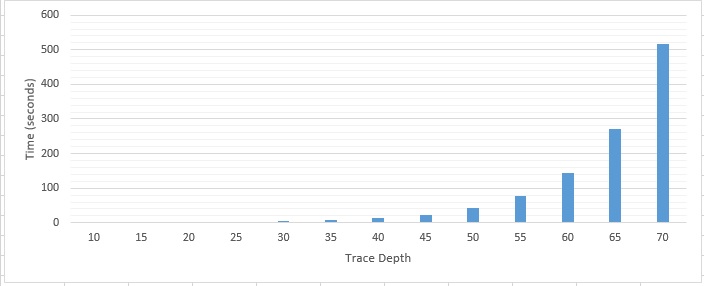Skynet/GPU610
GPU610/DPS915 | Student List | Group and Project Index | Student Resources | Glossary
Team Pages: GPU610 | GAM531
Contents
Ray Tracer
Team Members
- Michael Wang, (responsibility tbd)
- Bruno Pereira, (responsibility tbd)
- ...
Progress
Assignment 1
Bruno: For assignment 1 I looked into finding a simple Ray Tracer that could be easily understood by someone with no image processing background and benefit from parallelization.
I found ray tracer that matched the criteria I was looking for at http://scratchapixel.com/assets/Uploads/Lesson001/Source%20Code/raytracer.cpp
Looking into Big O notation I believe this program falls under [f(n) = n ^ 2]
I profiled the ray tracer by modifying trace depths, as seen below:
Depth of 70
Each sample counts as 0.01 seconds.
% cumulative self self total time seconds seconds calls ms/call ms/call name 99.99 517.97 517.97 307200 1.69 1.69 Vec3<float> trace<float>(Vec3<float> const&, Vec3<float> const&, std::vector<Sphere<float>*, std::allocator<Sphere<float>*> > const&, int const&) 0.01 518.00 0.03 void render<float>(std::vector<Sphere<float>*, std::allocator<Sphere<float>*> > const&) 0.00 518.00 0.00 1 0.00 0.00 _GLOBAL__sub_I_main
The program spends nearly 100% of all processing with in its Vec3 trace method, this is a recursive method.
Vec3<T> trace(const Vec3<T> &rayorig, const Vec3<T> &raydir,const std::vector<Sphere<T> *> &spheres, const int &depth)
....... .......
if ((sphere->transparency > 0 || sphere->reflection > 0) && depth < MAX_RAY_DEPTH) {
T facingratio = -raydir.dot(nhit);
// change the mix value to tweak the effect
T fresneleffect = mix<T>(pow(1 - facingratio, 3), 1, 0.1);
Vec3<T> refldir = raydir - nhit * 2 * raydir.dot(nhit);
refldir.normalize();
Vec3<T> reflection = trace(phit + nhit * bias, refldir, spheres, depth + 1);
Vec3<T> refraction = 0;
if (sphere->transparency) {
T ior = 1.1, eta = (inside) ? ior : 1 / ior;
T cosi = -nhit.dot(raydir);
T k = 1 - eta * eta * (1 - cosi * cosi);
Vec3<T> refrdir = raydir * eta + nhit * (eta * cosi - sqrt(k));
refrdir.normalize();
refraction = trace(phit - nhit * bias, refrdir, spheres, depth + 1);
}
surfaceColor = (reflection * fresneleffect + refraction * (1 - fresneleffect) * sphere->transparency) * sphere->surfaceColor;
} ... ...
void render(const std::vector<Sphere<T> *> &spheres)
{ unsigned width = 640, height = 480;
Vec3<T> *image = new Vec3<T>[width * height], *pixel = image;
T invWidth = 1 / T(width), invHeight = 1 / T(height);
T fov = 30, aspectratio = width / T(height);
T angle = tan(M_PI * 0.5 * fov / T(180));
// Trace rays
for (unsigned y = 0; y < height; ++y) {
for (unsigned x = 0; x < width; ++x, ++pixel) {
T xx = (2 * ((x + 0.5) * invWidth) - 1) * angle * aspectratio;
T yy = (1 - 2 * ((y + 0.5) * invHeight)) * angle;
Vec3<T> raydir(xx, yy, -1);
raydir.normalize();
*pixel = trace(Vec3<T>(0), raydir, spheres, 0);
} }
